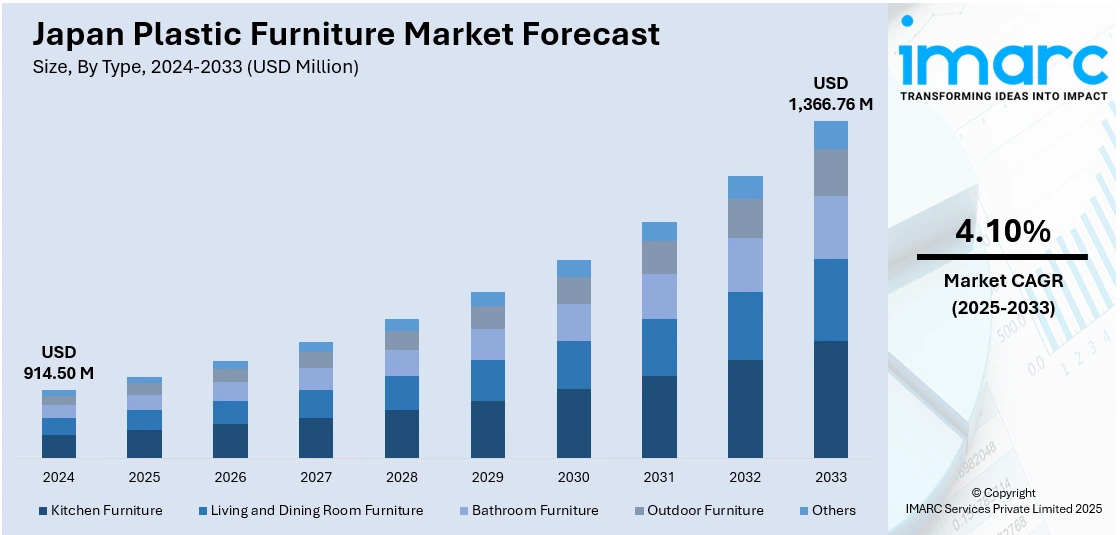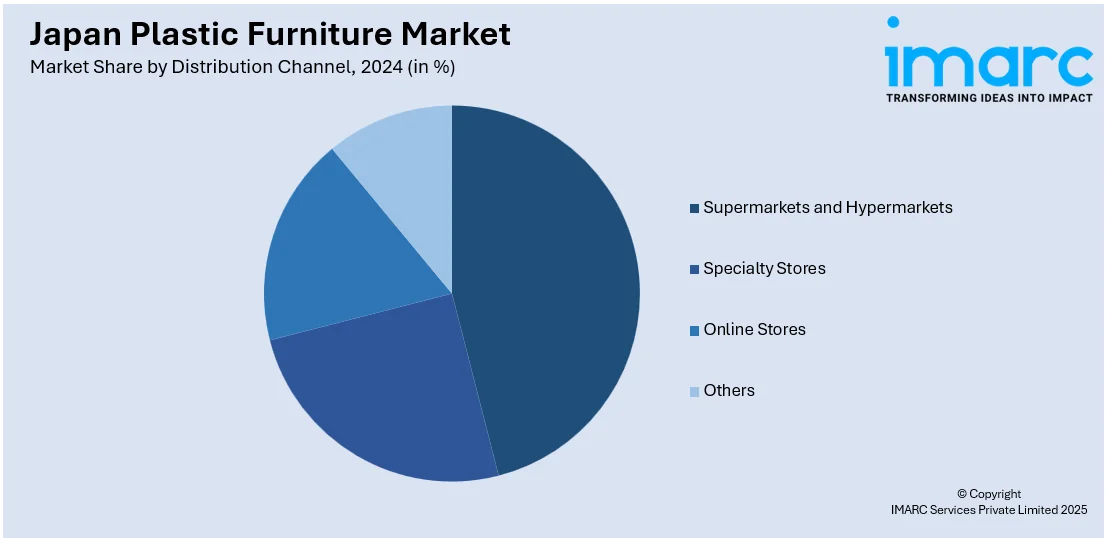
Japan Plastic Furniture Market Size, Share, Trends and Forecast by Type, Distribution Channel, End User, and Region, 2025-2033
Japan Plastic Furniture Market Overview:
The Japan plastic furniture market size reached USD 914.50 Million in 2024. Looking forward, IMARC Group expects the market to reach USD 1,366.76 Million by 2033, exhibiting a growth rate (CAGR) of 4.10% during 2025-2033. The market is driven by compact urban living, demand for affordable and durable home solutions, rising eco-consciousness favoring recycled materials, and growth of e-commerce industry. Lightweight, space-saving designs appeal to modern households, while online retail expands accessibility, making plastic furniture an increasingly practical and sustainable choice nationwide, further fueling the Japan plastic furniture market share.
|
Report Attribute
|
Key Statistics
|
|---|---|
|
Base Year
|
2024
|
|
Forecast Years
|
2025-2033
|
|
Historical Years
|
2019-2024
|
| Market Size in 2024 | USD 914.50 Million |
| Market Forecast in 2033 | USD 1,366.76 Million |
| Market Growth Rate 2025-2033 | 4.10% |
Japan Plastic Furniture Market Trends:
Urbanization and Compact Living Spaces
Japan’s dense population and high urbanization rates have led to smaller homes, especially in major cities like Tokyo and Osaka. Modern residents adopt furniture products with multifunctional features and lightweight structures that require minimal space. The portable and compact nature of plastic furniture makes it ideal for installation in such environments. Japanese apartments benefit from plastic furniture because it retains mobility while offering facilities for stackable and space-efficient storage. Plastic furniture manufacturers create their designs using modular building blocks to match modern interior design preferences, which value functionality. With real estate prices remaining high, particularly in urban centers, consumers prioritize versatile furnishings that can adapt to limited space, making plastic furniture an attractive, practical choice for both renters and homeowners in Japan’s evolving housing landscape.

Affordability and Low Maintenance Appeal
Plastic furniture offers a cost-effective alternative to traditional wood or metal furnishings, making it especially attractive in a country where disposable income is under pressure due to rising living costs. In Japan, consumers value practicality and long-term usability, and plastic furniture meets these expectations with its resistance to moisture, rust, and damage. Unlike wooden items that require careful upkeep, plastic pieces are easy to clean, lightweight, and suitable for both indoor and outdoor use. This low-maintenance quality appeals to busy urban professionals and families alike. Additionally, Japan's aging population favors furniture that is easier to handle and less physically demanding to move or clean, further strengthening demand for durable, user-friendly plastic options.
E-commerce and Changing Retail Preferences
The rise of e-commerce in Japan has made plastic furniture more accessible than ever, which is driving the Japan plastic furniture market growth. Online platforms allow consumers to browse a wide range of styles, sizes, and colors from the comfort of their homes. This convenience is especially important in a culture where in-store space is limited and urban traffic can be a deterrent. Moreover, the ease of shipping lightweight plastic furniture supports the logistical needs of online retailers. Japanese consumers are also influenced by design trends found on social media and shopping platforms, further fueling demand for stylish yet affordable furniture. Flash sales, home delivery, and flexible return policies make plastic furniture an attractive and low-risk online purchase, contributing significantly to market expansion.
Japan Plastic Furniture Market Segmentation:
IMARC Group provides an analysis of the key trends in each segment of the market, along with forecasts at the country and regional levels for 2025-2033. Our report has categorized the market based on type, distribution channel, and end user.
Type Insights:
- Kitchen Furniture
- Living and Dining Room Furniture
- Bathroom Furniture
- Outdoor Furniture
- Others
The report has provided a detailed breakup and analysis of the market based on the type. This includes kitchen furniture, living and dining room furniture, bathroom furniture, outdoor furniture, and others.
Distribution Channel Insights:

- Supermarkets and Hypermarkets
- Specialty Stores
- Online Stores
- Others
A detailed breakup and analysis of the market based on the distribution channel have also been provided in the report. This includes supermarkets and hypermarkets, specialty stores, online stores, and others.
End User Insights:
- Residential
- Commercial
A detailed breakup and analysis of the market based on the end user have also been provided in the report. This includes residential and commercial.
Regional Insights:
- Kanto Region
- Kansai/Kinki Region
- Central/ Chubu Region
- Kyushu-Okinawa Region
- Tohoku Region
- Chugoku Region
- Hokkaido Region
- Shikoku Region
The report has also provided a comprehensive analysis of all the major regional markets, which include the Kanto Region, Kansai/Kinki Region, Central/ Chubu Region, Kyushu-Okinawa Region, Tohoku Region, Chugoku Region, Hokkaido Region, and Shikoku Region.
Competitive Landscape:
The market research report has also provided a comprehensive analysis of the competitive landscape. Competitive analysis such as market structure, key player positioning, top winning strategies, competitive dashboard, and company evaluation quadrant has been covered in the report. Also, detailed profiles of all major companies have been provided.
Japan Plastic Furniture Market News:
- In April 2024, Yusuke Okumura, a Japanese businessman, started a creative company that turns plastic waste into furniture and other home goods. Gomi Recycle is a manufacturing base that specializes in turning plastic trash into useful products for the local market. It is situated in Kambol district.
Japan Plastic Furniture Market Report Coverage:
| Report Features | Details |
|---|---|
| Base Year of the Analysis | 2024 |
| Historical Period | 2019-2024 |
| Forecast Period | 2025-2033 |
| Units | Million USD |
| Scope of the Report |
Exploration of Historical Trends and Market Outlook, Industry Catalysts and Challenges, Segment-Wise Historical and Future Market Assessment:
|
| Types Covered | Kitchen Furniture, Living and Dining Room Furniture, Bathroom Furniture, Outdoor Furniture, Others |
| Distribution Channels Covered | Supermarkets and Hypermarkets, Specialty Stores, Online Stores, Others |
| End Users Covered | Residential, Commercial |
| Regions Covered | Kanto Region, Kansai/Kinki Region, Central/ Chubu Region, Kyushu-Okinawa Region, Tohoku Region, Chugoku Region, Hokkaido Region, Shikoku Region |
| Customization Scope | 10% Free Customization |
| Post-Sale Analyst Support | 10-12 Weeks |
| Delivery Format | PDF and Excel through Email (We can also provide the editable version of the report in PPT/Word format on special request) |
Key Questions Answered in This Report:
- How has the Japan plastic furniture market performed so far and how will it perform in the coming years?
- What is the breakup of the Japan plastic furniture market on the basis of type?
- What is the breakup of the Japan plastic furniture market on the basis of distribution channel?
- What is the breakup of the Japan plastic furniture market on the basis of end user?
- What is the breakup of the Japan plastic furniture market on the basis of region?
- What are the various stages in the value chain of the Japan plastic furniture market?
- What are the key driving factors and challenges in the Japan plastic furniture?
- What is the structure of the Japan plastic furniture market and who are the key players?
- What is the degree of competition in the Japan plastic furniture market?
Key Benefits for Stakeholders:
- IMARC’s industry report offers a comprehensive quantitative analysis of various market segments, historical and current market trends, market forecasts, and dynamics of the Japan plastic furniture market from 2019-2033.
- The research report provides the latest information on the market drivers, challenges, and opportunities in the Japan plastic furniture market.
- Porter's five forces analysis assist stakeholders in assessing the impact of new entrants, competitive rivalry, supplier power, buyer power, and the threat of substitution. It helps stakeholders to analyze the level of competition within the Japan plastic furniture industry and its attractiveness.
- Competitive landscape allows stakeholders to understand their competitive environment and provides an insight into the current positions of key players in the market.
Need more help?
- Speak to our experienced analysts for insights on the current market scenarios.
- Include additional segments and countries to customize the report as per your requirement.
- Gain an unparalleled competitive advantage in your domain by understanding how to utilize the report and positively impacting your operations and revenue.
- For further assistance, please connect with our analysts.
 Request Customization
Request Customization
 Speak to an Analyst
Speak to an Analyst
 Request Brochure
Request Brochure
 Inquire Before Buying
Inquire Before Buying




.webp)




.webp)












